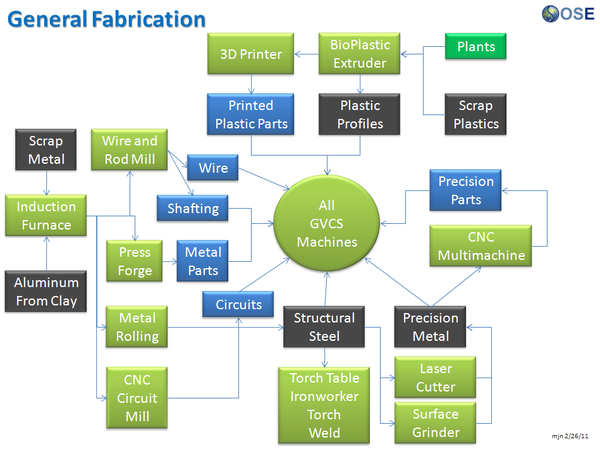Metal Roller: Difference between revisions
No edit summary |
No edit summary |
||
| Line 3: | Line 3: | ||
[[Category:Metal Roller]] | [[Category:Metal Roller]] | ||
==Overview== | |||
The metal roller sends sheet metal and plate through gaps between cylinders to roll-bend them; this operation is used for producing cylindrical or conical components as well as wiring cylindrical edges. | |||
<html>insert video embed code here</html> | |||
[[GVCSTool/Videos]] | |||
==Detailed Description== | |||
The metal roller is a universal "four-in-one" machine (meaning four cylinders to work with) that performs pinch rolling operations (lightly grips and moves sheet metal through the machine with a "free" roller to "set" the required bend radius) and pyramid rolling operations (moves plate metal through the machine to "set" the required bend radius). A hydraulically power-driven universal metal roller can be used for all required roll-bending operations. | |||
==Solution Statement== | |||
The metal roller allows the operator to perform roll-bending operations with ease. | |||
==Product Ecology== | |||
The metal roller fulfills the roll-bending role of metalworking operations in the GVCS. This ability is particularly useful for producing standard shapes of metal that would be time-consuming or impossible to form otherwise. | |||
[[Image:2b-Genfabecology.png|border|600px|General Fabrication]] | |||
==Components== | |||
The principal elements of the metal roller include: | |||
*Frame: the ground-supported structure upon which the rest of the metal roller lies | |||
*Couplers: the mechanisms that convert rotary motion from the hydraulic motor to the cylinders | |||
*Hydraulic Circuit: the set of components that powers the hydraulic motor by sending pressurized fluid through its ports, hence producing rotary motion at the motor shaft | |||
*Adjusters: the mechanisms that allow cylinder movement for different placement configurations on the plane perpendicular to the axis of rotation | |||
*Cylinders: the components that make actual contact with the workpiece for roll-bending. | |||
==Specifications== | |||
{| cellpadding="6" cellspacing="2" border="1" align="center" | |||
|-align="center" | |||
! '''Spec''' | |||
! '''Value''' | |||
|-align="center" | |||
! Spec | |||
! Value | |||
|} | |||
==OSE Project Status/Schedule== | |||
{{wanted|Versioning, milestones met, future goals}} | |||
Revision as of 00:45, 21 August 2011
| Metal Roller | ||
|---|---|---|
| Home | Research & Development | Bill of Materials | Manufacturing Instructions | User's Manual | User Reviews | 
| |
Overview
The metal roller sends sheet metal and plate through gaps between cylinders to roll-bend them; this operation is used for producing cylindrical or conical components as well as wiring cylindrical edges.
insert video embed code here
Detailed Description
The metal roller is a universal "four-in-one" machine (meaning four cylinders to work with) that performs pinch rolling operations (lightly grips and moves sheet metal through the machine with a "free" roller to "set" the required bend radius) and pyramid rolling operations (moves plate metal through the machine to "set" the required bend radius). A hydraulically power-driven universal metal roller can be used for all required roll-bending operations.
Solution Statement
The metal roller allows the operator to perform roll-bending operations with ease.
Product Ecology
The metal roller fulfills the roll-bending role of metalworking operations in the GVCS. This ability is particularly useful for producing standard shapes of metal that would be time-consuming or impossible to form otherwise.
Components
The principal elements of the metal roller include:
- Frame: the ground-supported structure upon which the rest of the metal roller lies
- Couplers: the mechanisms that convert rotary motion from the hydraulic motor to the cylinders
- Hydraulic Circuit: the set of components that powers the hydraulic motor by sending pressurized fluid through its ports, hence producing rotary motion at the motor shaft
- Adjusters: the mechanisms that allow cylinder movement for different placement configurations on the plane perpendicular to the axis of rotation
- Cylinders: the components that make actual contact with the workpiece for roll-bending.
Specifications
| Spec | Value |
|---|---|
| Spec | Value |
OSE Project Status/Schedule
Wanted: Versioning, milestones met, future goals
